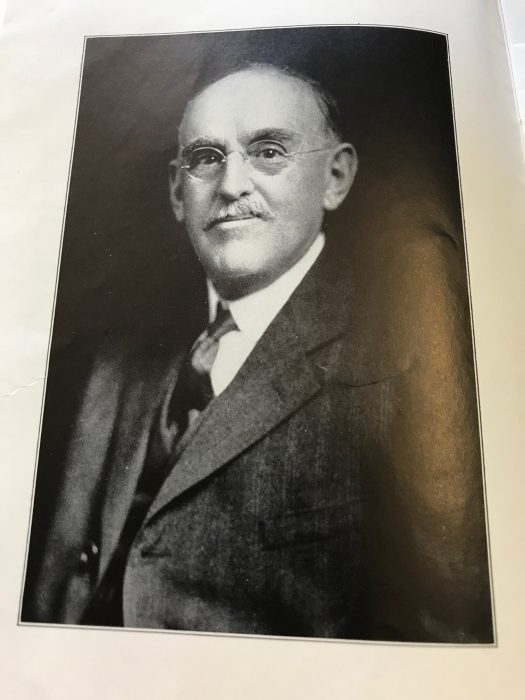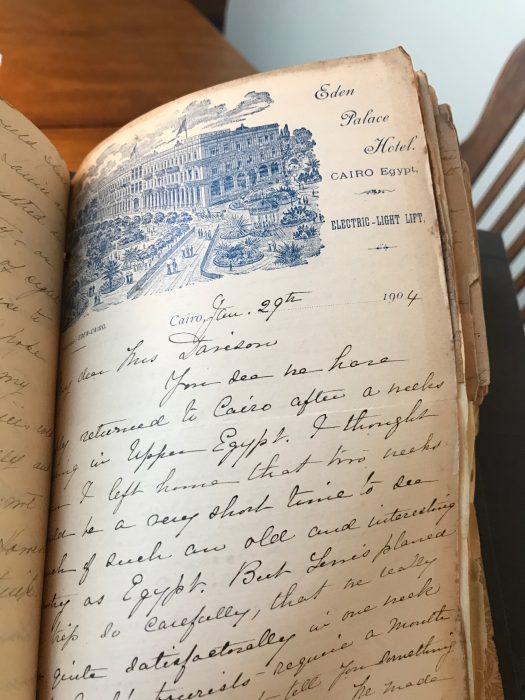Among the many collections of personal papers held at The Burke, there is a small cache of materials belonging to Biblical geographer Lewis Bayles Paton and his first wife, Suvia Davison Paton. The Patons traveled throughout the Middle East in the early 20th century and Lewis led the American School for Oriental Study and Research in Palestine (based in Jerusalem) from 1903-1904. I was particularly interested in the documents written by Suvia Davison Paton, as they are mostly personal correspondence and diaries from her travels in Europe and the Middle East. Such travel accounts are invaluable in helping historians reconstruct Americans’ experiences abroad over 100 years ago but they are also poignant since they record how places change over time and how they remain the same despite the passage of many decades. Below are some anecdotes from the letters and diaries of Lewis and Suvia that really resonated with me. They offer a window into the lives of intrepid theologians and travelers in the early 20th century.

Suvia’s description of a June 1890 visit to the Blue Grotto at Italy’s island of Capri is remarkably similar to the experience of a 21st century traveler on the island. Suvia and her husband visited Capri from Naples, traveling by ferry the 26 miles from the mainland to the island. “We were taken to the blue grotto first & left the steamer in row boats to enter the grotto as it is only 3 ft. high at the entrance. Everyone was obliged to get down in the bottom of the boat as we passed through the grotto but the grotto is 40 or 50 ft. high in the centre. A dozen boats were in it at the same time as all the passengers entered the cave & only 3 are allowed in one boat beside the boatman.”
Some years later, in the early 20th century, while they visited Venice, Italy, Lewis and Suvia attended Sunday morning mass at the Scotch Presbyterian church and she describes a quaint, intimate service: “About 40 people were present. The Scotch minister and his wife are earnest people & very pleasant. Afterwards there was a communion service to which we were all invited. 25 remained. The minister passed the one silver goblet of wine & a small plate of bread. It was a simple but impressive service which we all enjoyed. It reminded us of the gathering of the disciples in an upper chamber.”
When Lewis and Suvia journeyed to the Middle East in June 1903 so Lewis could continue his studies and lead the American School for Oriental Study and Research in Palestine, they landed first in Beirut. Geopolitics have changed significantly since the Patons’ arrival, as both Lewis and Suvia describe Beirut as being a city in Syria. Lebanon didn’t even exist as an independent nation! The Patons spent time in Damascus, Beirut, Smyrna, Palestine, and Egypt, visiting ancient sites like Jericho, the Sea of Galilee, and the Cedars of Lebanon.


According to Lewis’ Report of the Director, 1903-04, written for the Managing Committee of the American School of Archaeology in Palestine (which included representatives from both Union Theological Seminary and Columbia University), his own studies were “devoted chiefly to the topography of ancient Jerusalem. I investigated all the archaeological remains that were accessible, and obtained a large collection of excellent photographs. …At the request of the Trustees of Hartford Theological Seminary [where Paton taught] I took advantage of my residence in Jerusalem and my trips to other parts of the country to make a quite complete collection of objects illustrating the life of the Bedawins and of the Fellahin. This collection is now on exhibition in the Museum of Hartford Theological Seminary, where it is open to the inspection of the public.” One wonders where these artifacts are today!
Lewis and Suvia led a very full life during their time in Jerusalem, participating in archaeological excavations and socializing with other scholars and diplomats residing in the region in this period. Tragedy struck in March 1904 when Suvia fell off the horse she was riding near Amman, Jordan and died shortly after, never regaining consciousness. Lewis touchingly records the incident in his report to the Managing Committee:
“Late in the spring, just before the end of the School year, we planned a tour in company of Dr. Masterman of Jerusalem, to make a more thorough study of ‘Araq el-Amir, then to visit Amman, Jerash, Pella, the Decapolis, and to return by way of Beisan and Nablus. We had gone as far as Amman, and were just starting on the road to Jerash. It was a cool, cloudy morning, and we were riding slowly over a level, grassy spot, when suddenly, without any warning, and without uttering a cry, Mrs. Paton fell from her horse. Her head struck on a sharp stone, and she never regained consciousness. We were able to move her to the Amman station on the new pilgrimage railway from Damascus to Mecca, and to take her in a train to Damascus. She died on the train within two hours of Damascus, and I was obliged to bury her body in Damascus. She was the constant companion of my travels, and whatever success may have attended the work of the School during the past winter is due to her enthusiasm and brave willingness to put up with the inconveniences of life in Palestine.”
It must have been so shocking and so awful for everyone involved, particularly Lewis, to have lost his beloved young wife suddenly and unexpectedly. Their young daughter had already gone back to the United States several months earlier but one feels, even more than a century later, so much sympathy for the family at such a devastating loss. The Paton collection at The Burke includes several carefully snipped and pasted obituaries and newspaper articles documenting Suvia’s death.

Lewis Bayles Paton went on to marry two more times before his death in 1932 and he enjoyed a successful career teaching and writing on diverse theological subjects. Anyone interested in Biblical geography, Western perceptions of the Middle East in the early 20th century, or personal travel accounts from a pair of adventurous Americans, should look to the Paton papers for illumination.
These were my great grandparents. I never knew these papers existed. While living in Jerusalem myself in 2019-2020 (just before the Pandemic), I learned through online “research” (poking about ,which is what brought me to this site as well) that my great grandmother is buried in Damascus — I had always assumed she was somewhere in Israel or perhaps Jordan.
She pressed many flowers — my sister and I inherited the family effects, which include an album of flowers, very dry and brown now.
As a Jew-by-choice, I find this branch of my family tree particularly interesting.
My sister has the name Suvia, as did my mother and grandmother. There is a bit of family lore (perhaps mythical!) invovling a person with that name, a young girl who was rescued off a shipwreck on the coast of Massachusetts and adopted into the Davison family.